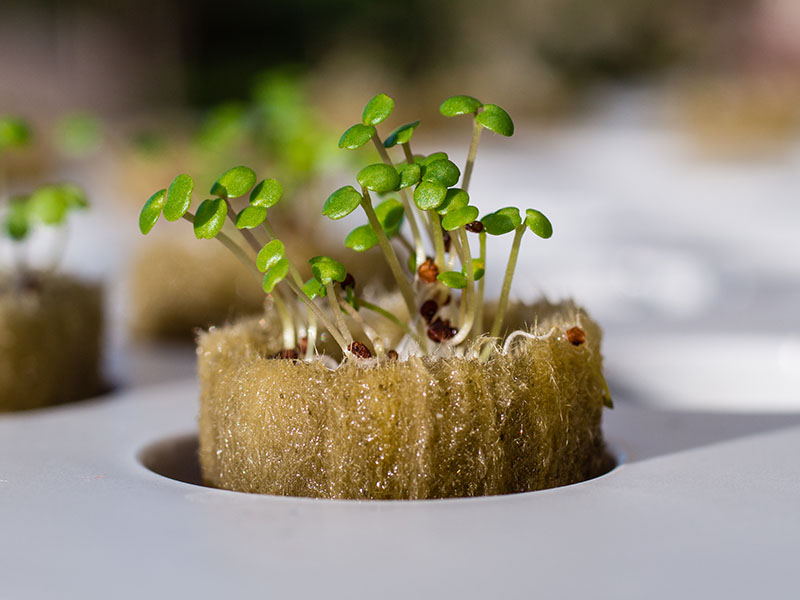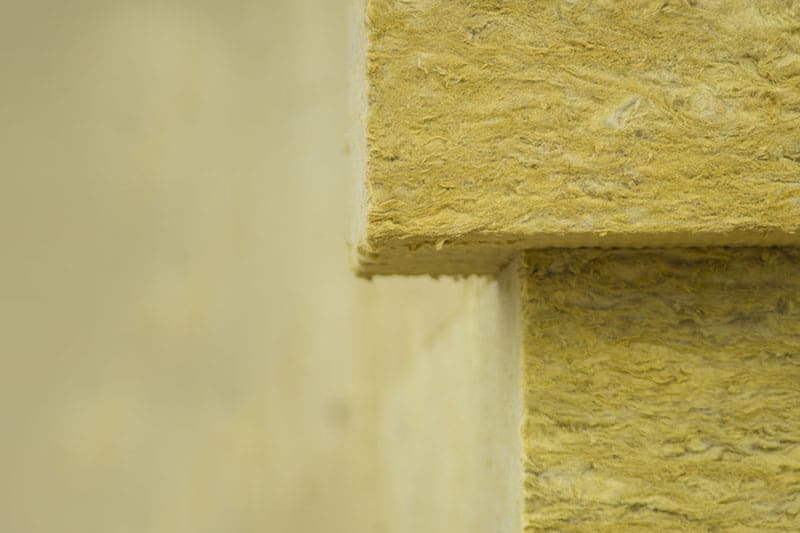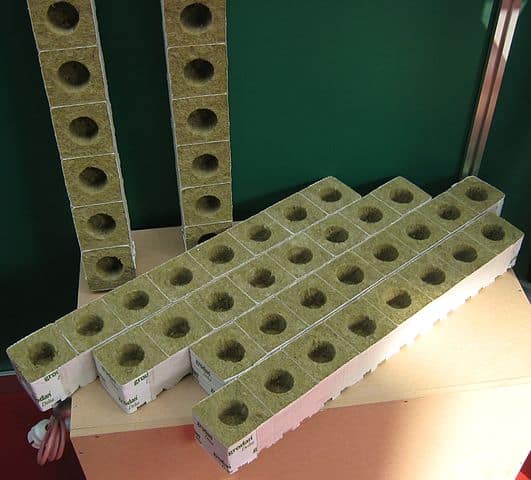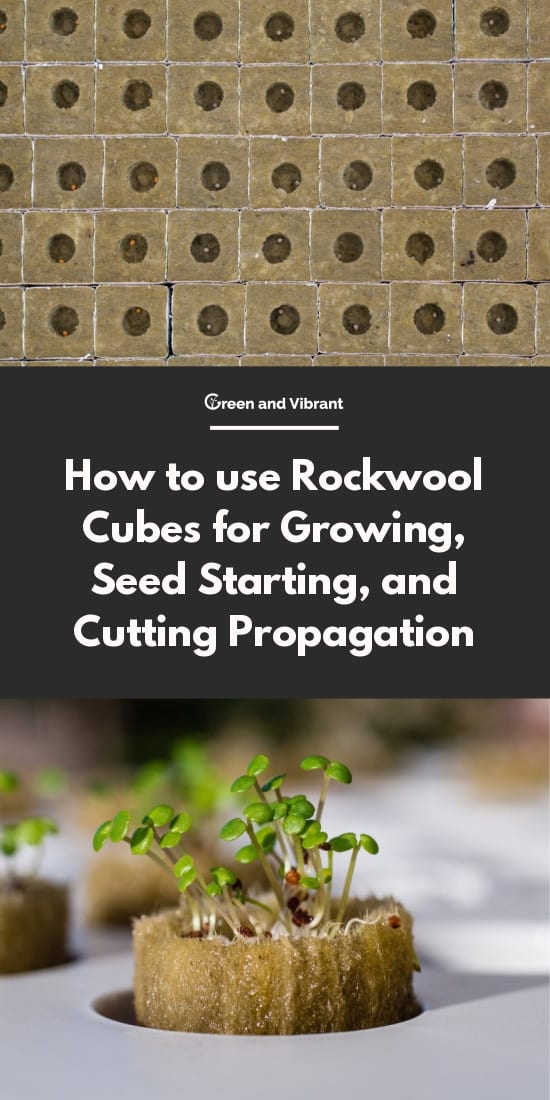Trees are among the most notable plants in any landscape. But growing and ... Read More
- Home >
- How to use Rockwool Cubes for Growing, Seed Starting, and Cutting Propagation
How to use Rockwool Cubes for Growing, Seed Starting, and Cutting Propagation

Rockwool is a mainstay growing media for commercial hydroponics growers, primarily those who implement drip irrigation systems. Originally used as insulation and also known as mineral wool or stone wool, rockwool was developed in Denmark back in the 1970’s for gardening. It retains moisture well, it retains oxygen well, it never impedes root growth, it is chemically inert, and it comes in a variety of sizes and shapes. These benefits contribute to its popularity amongst growers, accommodating almost any plant they are growing.
Here is my favorite Rockwool brand.
GRODAN
A OK Rockwool Stonewool Hydroponic Grow Media Starter Cubes Plugs + THCity Gloves
Great moisture retention without drowning the seeds. Cheap and reliable starter cubes for seed starting and germination
What are Rockwool Cubes?
Similar in texture to steel wool, rockwool is a dense mat consisting of long strands of natural fibers. Basalt rock and chalk are combined and then melted at a very high temperature (approximately 3000°F) to form lava. Then people throw the lava into a spinning chamber to create the fibers in a process much like making cotton candy.
Due to the firing process, rockwool cubes are chemically and biologically inert. This creates an ideal growing medium for hydroponic growing systems.
After the fibers are spun, they are mixed with a binding agent and pressed into large mats. The mats are then cut into various sizes of cubes and slabs to be sold to customers as a growing medium for plants.
Rockwool cubes are popular with hydroponics growers, as well as conventional growers because of their beneficial structure. When the fibers are spun it creates a structure that is perfectly suited to retain water while holding more oxygen than typical soil mediums. The increased water holding capacity and oxygenation within the root zone is exceptionally beneficial when starting seeds and rooting propagation cuttings.
Another benefit to rockwool cubes is they are considered to be a natural product even though they are man made. This is because they originate from basaltic rock and chalk which are natural ingredients. Being considered a natural product makes them acceptable in organic growing systems, increasing their popularity.
Their inert nature also means growers can quickly adjust the conditions within the root zone to meet the needs of plants. A non-existent cation exchange capacity (CEC) prevents nutrients from being changed by the growing medium or tied up and made unavailable for plant uptake. The cubes can also be quickly rinsed with fresh water, leaching fertilizer salts out.
Rockwool cubes come in a couple of different sizes. The smallest ones work well for starting seeds and propagating stem and leaf cuttings; the larger cubes are used by growers to grow more compact plants.
Do’s and Don’ts of using Rockwool Cubes

- DO take the time to properly prepare rockwool cubes before starting seeds or trying to root cuttings. Their natural pH is too high for optimum plant growth and will create problems and instability within the hydroponics system if left at that alkalinity.
- DO wear protective gear to keep yourself safe when handling rockwool material. The fibers are irritating to skin, lungs, and eyes so it’s imperative to protect yourself. At the minimum, wear a dust mask to prevent inhaling fibers into your lungs. It’s also recommended to wear eye protection and long sleeves if there is a chance of prolonged contact with your skin.
- DO sterilize the feeding solution before running it back through the rockwool cubes. Even though it is a manmade, inert material, it can still be prone to algae and bacterial growth that can contaminate the hydroponics system if the feed solution is recirculated without being treated properly.
- DO dispose of the materials properly after you are done using the cubes. Unlike other growing mediums, rockwool is not composed of natural materials so it will not break down over time. If it reaches the landfill it will be there indefinitely. Instead of throwing them away, break up the pieces and work them into your garden or potting soil to help increase their water retention.
- DO heat treat the rockwool cubes if you are going to reuse them for a successive growing season, or even numerous seasons. This can be done by steaming them, or pouring boiling hot water through them to kill off any bacteria or fungus that may be residing with the cube’s fibers. Some websites recommend using chemical treatments to sterilize rockwool cubes to use again but this can be dangerous unless you are absolutely sure you have rinsed all of the sanitizing chemicals out of the fibers.
- DON’T squeeze the cubes when they are wet. If you need to remove some of the water from them after preparing them in a pH controlled solution it’s best to shake them gently. Rockwool cubes are known for their internal structure that gives them such great water holding capacity and oxygen movement; squeezing them compacts the structure and hinders the benefits they are so well known for.
- DON’T forget rockwool is completely inert and can not provide any nutritional value to the plants growing in the cubes. Everything the plant needs has to come from the nutrient solution supplied to them.
How to Prepare Rockwool
Before using your rockwool in a hydroponics system it’s important to prepare it for use. Unlike other pH-neutral hydroponic growing media like Hydroton, and Coco Coir, Rockwool has a naturally high pH, typically around 8.0, because of the way it’s manufactured. During the process there is an abundance of lime that is deposited on the fibers; lime naturally neutralizes acidity, raising the pH.
A pH of 8.0 isn’t optimum for growing plants so it needs to be adjusted to a level that is better suited for growth. A higher pH will make many plant essential nutrients unavailable for plant uptake, causing deficiency symptoms. Most plants prefer to grow in slightly acidic conditions, and will benefit if the pH of rockwool cubes is brought down to a more acidic level.
There are different ways to prepare rockwool for use, none of which are difficult, but they can be time consuming. Due to this you will need to account for a couple of days to prep rockwool before being able to use it.
The first step in preparing rockwool cubes is to soak them in acidic water to lower the pH. The acidic water will dissolve the lime that is formed on the fibers during the manufacturing process and the pH will drop to a better level.
It is best to use distilled water because of its purity but tap water can work in a pinch if it is the only thing available. Adjust the pH slowly until it reaches the desired 5.5; it is critical the pH doesn’t drop below 5.0 since it will start todamage the rockwool fibers when it is too acidic.
After Then submerge the rockwool cubes in the water and allow them to soak for up to 24 hours. When they have finished soaking, remove them from the water and carefully add them to the hydroponics system and allow the system to run without any plants until the pH of the system stays between 5.5 and 6.0 — this means the cubes are stable and can be used.
This video will show you how to prepare rockwool properly.
What are the Uses of Rockwool Cubes
Rockwool cubes hold a tremendous amount of water for their size, which provides a buffer against power outages that make shut down pumps or timers. On average they also hold at least 18% oxygen between the fibers providing a tremendous amount of oxygen to the root zone, as well as making it incredibly difficult to overwater the plants.
Growers primarily use rockwool cubes as growing media for two main purposes in their hydroponics systems: germinating seeds and propagating new cuttings. Typically the 1.5” cubes are used for starting seeds or propagating cuttings. Some of the larger cubes (up to 4”) are used as a growing medium for compact plants as well, but on a much smaller scale.
Germinating Seeds
Starting seeds can sometimes be a stressful adventure. It’s a constant balance between keeping them wet enough to promote germination without having them so wet they dampen off and die. Rockwool cubes are popular for germinating seeds in because of their excellent moisture retention — they are great at helping to keep seeds or seedlings from drying out but don’t let them sit in a waterlogged environment.
Moisture is the critical factor in seed germination. Water enters the seed through the seed coat or tiny opening called a micropyle. The presence of water will activate the enzymatic reactions within the seed that begin germination.
Cloning New Plants
Propagating new plants is the process of taking an existing plant part (usually a leaf or stem cutting) and growing it into a whole new plant. This method results in an identical clone of the original and is cheaper than purchasing seeds and starting from scratch.
Maintaining a high humidity around the cutting is critical for successful propagation. Plants need to keep from drying out; without enough moisture the plant will go into self-defense mode and will stop trying to develop new roots.
Growing new plants through propagation techniques needs to happen in a sterile environment, free of bacteria or fungus. Rockwool cubes are completely inert because of the heating process they undergo during manufacturing. This ensures they are sterile and free of any harmful microorganisms that could hinder propagation.
Step by Step Instructions Using Rockwool for Seed Plantings and Propagating Cutting
- Prepare the rockwool cubes for use, making sure to soak them in pH adjusted water to bring their pH down between 5.5 and 6.5.
- To Plant Seeds:
- Insert 2 seeds in the hole on the top of the rockwool cube. Use a toothpick or other similar object to press the seeds down to the bottom of the hole.
- Pinch the hole closed.
- Place the cubes in a nursery tray and cover with a humidity dome to lock in moisture.
- Maintain at 70 – 80°.
- Keep rockwool cubes moist by watering sparingly every couple of days or misting with a spray bottle when they start to dry out.
- Remove from humidity dome and place under lights as soon as seeds sprout.
- Cut the tops off the seed in each cube (if you planted 2 per cube) that isn’t the strongest or tallest. Do not pull them out as it may dislodge the healthier plantlet at the same time.
- Transplant when plantlets reach 2-3” in height.
- To Propagate Cuttings
- Water the stock plant well the night before beginning the propagation process.
- Remove a 3-4” leaf stem cutting from the main stem of the plant, cutting it off as close to the main stem as possible without damaging the node.
- Dip cut end in rooting hormone.
- Plant the cutting in the rockwool cube making sure it doesn’t poke out the bottom of the cube.
- Fill a nursery tray part way full with perlite or vermiculite.
- Set rockwool cubes on top of growing media.
- Cover nursery tray with a humidity dome to lock in moisture.
- Maintain close to 80°.
- Crack humidity dome when roots begin to emerge, gradually increasing the day after.
- Remove the humidity dome a couple of days after roots first appear.
- Transplant when roots begin to poke out the bottom of the cubes.
Conclusion
Rockwool cubes are an indispensable product in the hydroponics growing industry. Naturally occuring basaltic rock and chalk are melted down at really, really high temperatures in a molten lava. This lava is then put into a spinning chamber to create long fibers that are later formed into blocks or cubes for easy handling. Rockwool cubes are popular because they retain moisture and oxygen well and they never impede the development of roots. With a variety of sizes and shapes available, they are adaptable to almost any grower’s setup.
Related Content
-
Tree Care Tips & Techniques
-
A Complete Guide to Aquaponic Gardening
In this article, you will learn about the basics of aquaponics practice - ... Read More
-
Best Hydroponic Nutrients 2019: Reviews and Buying Guide
Your plants love nutrients as much as you need food to survive and grow. B... Read More
-
15 DIY Aquaponic Plans You Can Actually Build
Many people want their aquaponic system these days, and it is no wonder. I... Read More


